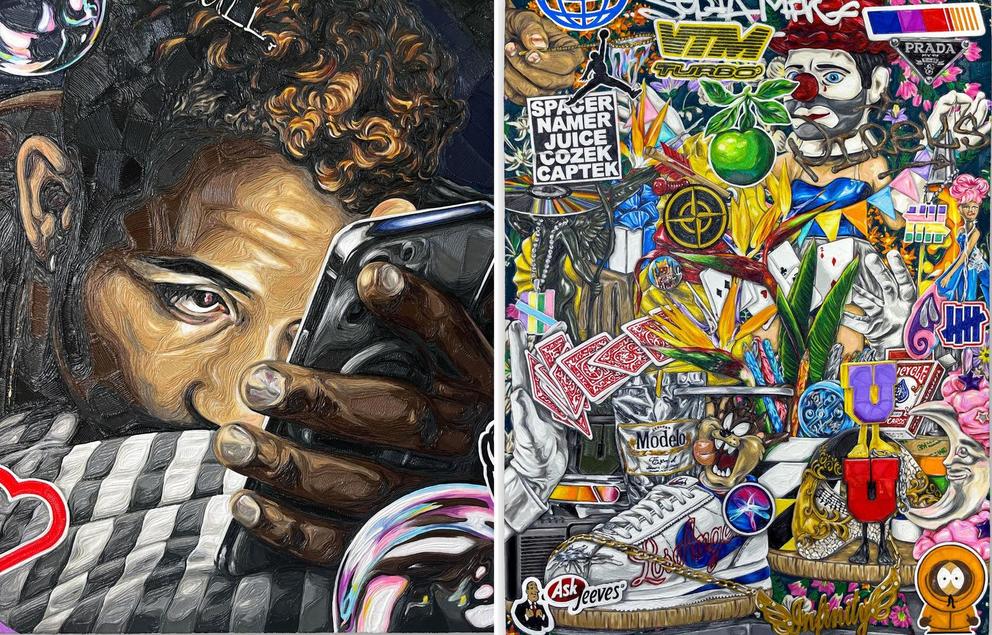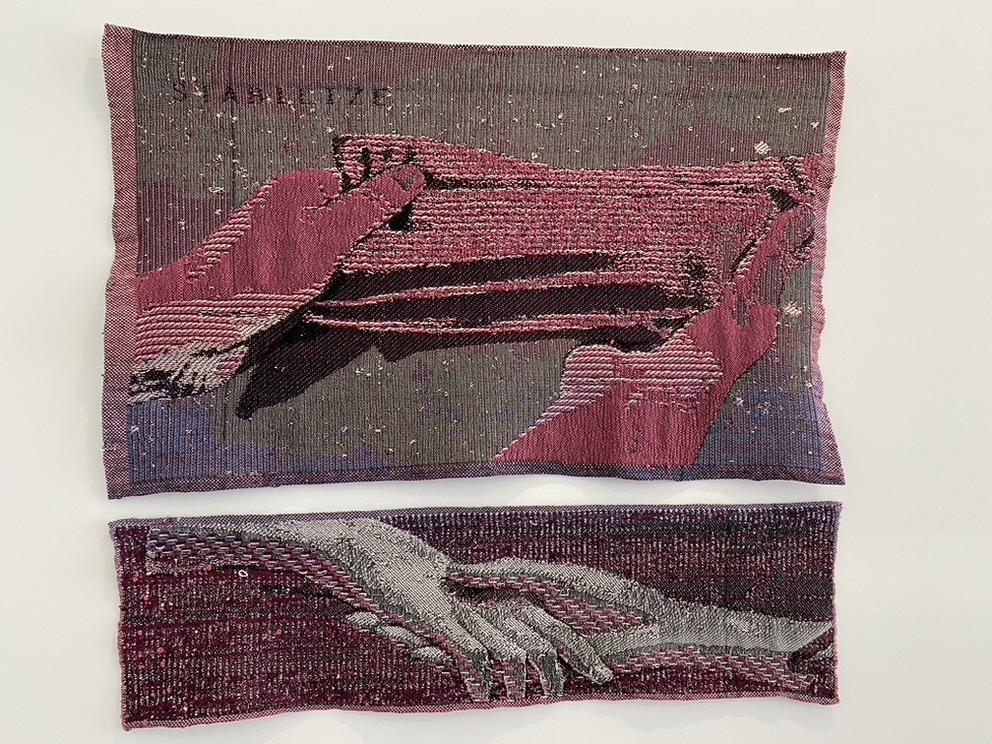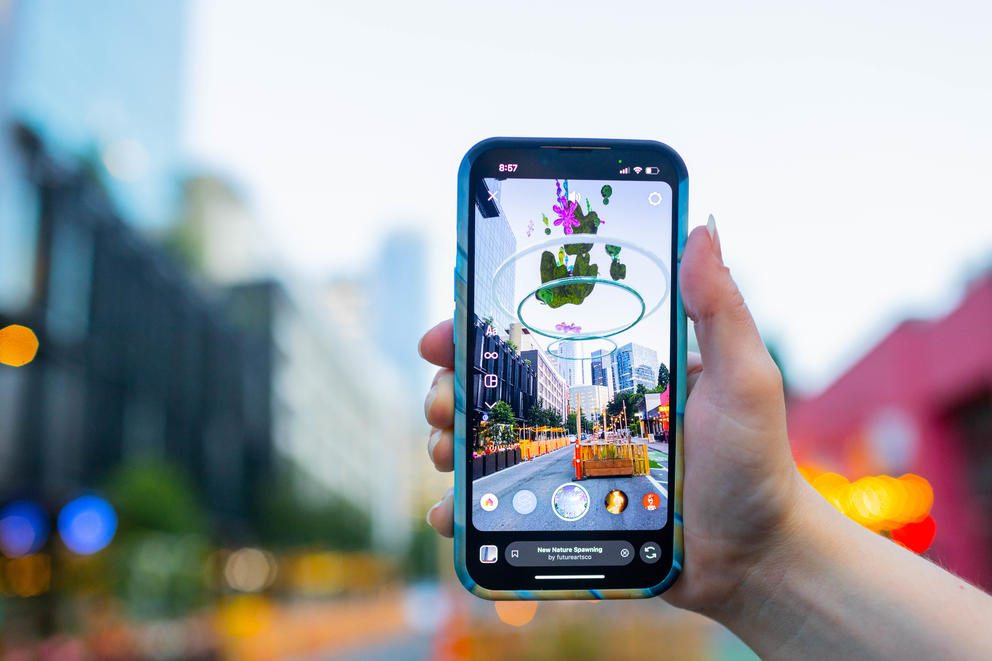The indefatigable, drum-beating battery mascot appears in a painting hung higher than the others, close to the ceiling. Its checkered backdrop seems to fold in on itself and the surface bears the telltale cracks of a phone screen that has hit the ground one too many times.
White says the bunny functions a bit like a messiah here (his family always hung an image of Jesus up high). But the drum the rabbit beats is not a message of sacrifice but the gospel of capitalism, the perpetual cult of “keep going.” “Unhealthy and damaging at its core — which is what most of my work examines,” White said over email earlier this week.
The cotton candy-pink bunny is not the only icon of capitalism, popular culture and (somewhat bygone) technology making an appearance in the show. Orange-coated Kenny from South Park stares at us from the corner of one painting, rubbing shoulders with Prada and Air Jordan logos, plus shiny CDs and gloved hands shuffling a set of playing cards. (That’s just one painting.) The glowing orb of the Apple Siri icon near the bottom enhances the feeling that we’re looking at a phone screen, a rabbit hole to who knows where.
Like the magic trick of a phone screen, this hyped-up world — a dizzying vortex of memes, images, “content” and purchases at our fingertips — exerts a thrilling pull. Standing in front of the paintings, you may find yourself wanting to decode every element like a digital-era archeologist. That’s part of the point: Much like in Dutch Vanitas paintings (an inspiration for White), each symbol, and the interplay between them, tells a story of “time, place, travel, relationships, experience, status, wealth, society,” White said. And like Vanitas paintings, much of those stories are rooted in extractive capitalism and consumerism.
In one particularly arresting work, White paints himself in a pose that will be familiar to those who bring their phones to bed: chin sunk into the pillow, phone in hand, face illuminated by the screen, eyes disconcertingly empty, hypnotized. The painting is a close-up, but White seems far away as he keeps scrolling, keeps going, and going, and going — but where? —M.V.S.
When admiring a beautifully woven wall hanging, you probably aren’t thinking about “coding.” But that’s how Seattle artist Allyce Wood describes the process behind her digital jacquard tapestries. Marrying ages-old textile traditions with a high-tech loom, Wood creates soft 3D abstractions — of chain links, plywood grain, coins, a blizzard — currently on view in Soft Systems (at Vestibule Gallery in Ballard, through Aug. 20).
“Weaving lends itself to planning in pixels,” she writes in the short zine she created for the show. “A weaving pattern consists of color blocks, each weft thread designating an up or down as well as a color. To create an image, a weaver must think in binaries of up/down, on/off.”
It’s not just a metaphor. Wood worked on enormous digital looms in Norway, Iceland and Ohio to translate drawn and photographed imagery into pixelated files. The computerized loom arranged the warp threads, leaving Wood to crisscross the weft herself. But unlike the computer, Wood varied from the preset pattern, changing texture and color at will, incorporating human creativity into the machine.
Fiber art is a thread you can follow across the city this weekend. Look for a loose weave at Mini Mart City Park in Georgetown, where local artist Megan Prince is showing her Jean Bodies and Friends (through Aug. 13). Using discarded fabrics — including a whole lot of denim — Prince creates netlike woven sculptures that look like nests for humans.
In Pioneer Square, head to the top floor of the RailSpur building to see one of my favorite corners of the multifaceted XO Seattle show (the indie alternative to Seattle Art Fair, open weekends through Aug. 21): several quilted, sewn and collaged fabric pieces by local artist Saina Heshmati.
“I always wanted to be a dancer,” Heshmati writes in her artist statement, “but my deep passion for dance had no chance to blossom in Iran.” Growing up in Tehran, girls like her were forbidden to dance in public, expected instead to learn sewing and cooking. As a result, Heshmati hated sewing. But here, she revisits the craft to express freedom of bodily movement via fabric.
Also in Pioneer Square, at Gallery 4Culture, Seattle artist Carlos Brache channels his Cuban American identity into an installation called “pan con timba” (through Aug. 26). Inspired by the tile floor of his grandfather’s car dealership in Cuba, Brache designed a bold geometric fabric and made it into an apron and pair of pants. That pair of pants shows up again — worn by a man seated on a chair on a tile floor — in a digitally woven tapestry. — B.D.
In more digital art news: This week I (Margo) got a preview of a brand-new, all-digital augmented reality art show in South Lake Union.
“Welcome to the future,” said Yuliya Bruk when I met her in front of a coffee shop on the corner of Ninth and Thomas. Bruk was there to walk me through AUGMENT Seattle, a new “mixed-reality urban showcase.” In this exhibit, the art can only be viewed on your phone, through an Instagram filter layered on top of whatever your camera picks up on. AUGMENT kicks off on Thursday (through Aug. 28, tours available on certain days).
Organized by the Seattle-based, female-led new media arts collective Future Arts, AUGMENT groups eight digital art pieces by local and international artists across one city street. The theme of this “IRL + URL” exhibit is “The New Nature.” “How are we working between the real world and the digital world?” Bruk asked. “We as humans are now existing in between.”
We stopped by a window decal featuring geometric shapes, by local artists Yes Segura and Gabriel-Bello Diaz. As I scanned the QR code and positioned my camera in front of the window, the shapes started to come alive and reached, at least on my screen, into the street like vines overtaking the sidewalk. As I looked closer, I realized what appeared to be growing from the flat surface was a three-dimensional thicket of salmonberry, Indian plum and wild ginger — native plants that rose up here long before the towers and tech offices did.
“I think technology is feeling disorienting, or sometimes disjointed from nature and from being human,” Bruk said, “and being an empathetic human being.” With Future Arts, Bruk wants to lean into using technology for something different: a “disarming” moment where you learn and think about your surroundings.”
But we’re still on our phones, I pointed out. “Augmented reality layers on top of the world to point out a story,” Bruk replied. “Virtual reality, or just scrolling inside of your phone, will check you out of the world.” — M.V.S.
Get the latest in local arts and culture
This weekly newsletter brings arts news and cultural events straight to your inbox.






